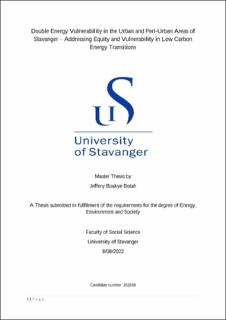| dc.description.abstract | Europe is experiencing critical energy crisis, and Norway is no exception. The surge in electricity prices in Stavanger has made low-income households unable to obtain the heat, electricity, and other essential energy services they need to survive. Further complicating matters, households in Rogaland face challenges accessing efficient and affordable transportation, resulting in disadvantages, and exacerbating inequalities among low-income and vulnerable residents. For this reason, the thesis aims to analyse the double energy vulnerability in the urban and peri-urban areas of Stavanger with the focus on addressing equity and vulnerability in the ongoing low-carbon energy transition.
The thesis builds on Sareen et al. (2022) paper on the Double Energy Vulnerability (DEV) in Stavanger's urban transport transition and examines the domestic and transport energy poverty in both the urban and peri-urban areas of Stavanger through the lens of the three core-tenet framework of energy justice – distribution, recognition, and procedural justice. It answers the questions of; (1) what characterises the energy-poor households in the urban and peri-urban areas of relatively affluent cities; (2) how do the factors of double energy vulnerability (DEV) exacerbate inequality, and (3) how can policies target double energy vulnerability to reduce inequality while ensuring fairness?
The thesis employs multiple qualitative methods. A semi-structured interview format, document analysis of scholarships and grey literature, a self-administered paper-based (expenditure) questionnaire, an online (perception-based) survey targeting specific social media interest groups, as well as primary data from the Norwegian Energy Poverty project were employed and analysed. Households at risk of double energy vulnerability were identified based on the 10% indicator and their lived-in experiences or subjective views.
The thesis found that double energy vulnerability is gradually emerging in Stavanger and that the geographic location of households determined their vulnerability to transport energy poverty. With low income and higher energy prices serving as the factors of double energy vulnerability exacerbating inequality, further findings revealed that low-income residents of Bryne were not recognized as having specific transportation needs, making them vulnerable to all forms of transport-related disadvantages (for example, forced car ownership, transportation affordability, transport accessibility, and car-related economic stress). As a specific recommendation, the thesis called for a detailed examination of energy poverty issues in municipalities and regions across Norway as well as how subsidies trickle down to those living on low incomes. | |
